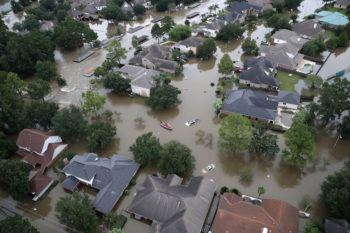Repeated Exposure To Major Disasters Has Long-Term Mental Health Impacts
A Texas A&M study found Houston residents who experienced two or more hazardous events in the past five years had a reduction in mental health scores.
 Flooded homes near Lake Houston following Hurricane Harvey Aug. 30, 2017 in Houston, Texas. | Win McNamee/Getty Images
Flooded homes near Lake Houston following Hurricane Harvey Aug. 30, 2017 in Houston, Texas. | Win McNamee/Getty Images
Repeated exposure to major disasters does not make people mentally stronger, a recent study from the Texas A&M University School of Public Health found: individuals who have been repeatedly exposed to major disasters show a reduction in mental health scores.
Additionally, the research team found that the more experience the individuals had with such events, the lower their mental health was.
“We discovered the reverse of the adage ‘what does not kill you makes you stronger,’” said the study’s lead author Garett Sansom, research assistant professor in the Department of Environmental & Occupational Health at the School of Public Health.
Sansom and a team of Texas A&M researchers studied individuals from the Houston area, which is susceptible to hurricanes and flooding as well as industrial emergencies. The results of the study were published recently in the journal Natural Hazards.
From 2000 to 2020, Texas — one of the states most prone to natural disasters — experienced 33 Federal Emergency Management Agency (FEMA) declared major disasters. Many of these — hurricanes, winter weather, drought and flooding — impacted the Houston area. The area has also been impacted by emergencies such as explosions and chemical releases at nearby industrial facilities.
According to the research team, the combination of natural disasters and emergencies from industrial facilities presents a unique opportunity to observe the impacts.
“There is an unfortunate truth that many communities that reside along the Gulf Coast are at the nexus of exposures from natural and anthropogenic, or human-caused, hazards,” Sansom said.
The team used a 12-item short form health survey to gather information. The survey assessed cumulative impacts from exposure to evaluate changes over time, producing a composite score for both mental (MCS) and physical (PCS) health.
The majority of the respondents reported that they experienced many hazardous events over the past five years. Hurricanes and flooding (96.35 percent) were the events experienced the most, followed by industrial fires (96.08), chemical spills (86.84) and tornados (79.82).
The team found that when individuals experienced two or more events over the past five years, their MCS averages fell below the expected national levels.
“Mental health is often overlooked in responding to and preparing for hazard exposures,” Sansom said. “However, in order to reach community resilience efforts, mental conditions need to be accounted for.”
The results of the study help to reveal the long-term mental impact hazards can have. More importantly, they underscore the need for public health interventions targeted toward these individuals as well as the communities where they reside.
Sansom’s co-authors include Courtney Thompson and Lindsay Sansom, both from the Texas A&M University Department of Geography, Leanne Fawkes, graduate research assistant in Environmental & Occupational Health, and Elizabeth Boerlin, doctoral student in Occupational Safety and Health
Publication: Garett T. Sansom, et al., Compounding impacts of hazard exposures on mental health in Houston, TX, Natural Hazards (2023). DOI: 10.1007/s11069-021-05158-x
Original Story Source: Texas A&M University

 Alerts Sign-up
Alerts Sign-up